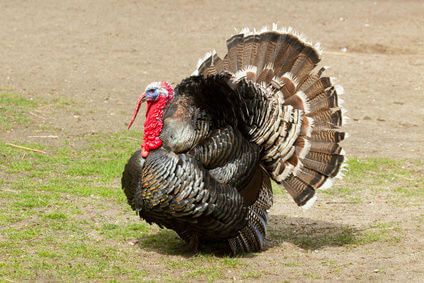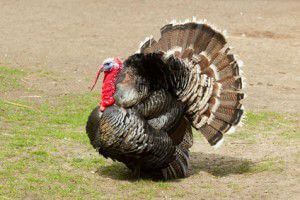
No one really knows for sure how the turkey became associated with Thanksgiving. Early American settlers kept records that tend to show that when early colonists dined with the Wampanoag Indians, fowl and beef were both served.
This meal became known as the first Thanksgiving. In a letter that has been preserved from pilgrim Edward Winslow, a turkey hunting trip before the gathering was mentioned, leading historians to believe that turkey was the fowl served.
The wild turkey is a native bird of North America and one which Benjamin Franklin felt deserved the honor of national bird for our country. However, the bald eagle was chosen, leaving just one very special day for us to celebrate the turkey. However, for most of us, the turkey of today is not what it used to be. What kind of turkey do you celebrate with?
Factory-Raised Turkeys
Turkeys are very curious by nature and love to meet other animals, enjoy the company of humans and are very protective parents. In the wild, chicks will remain with their mothers for a full year.
However, factory-raised turkeys start life in incubators, chicks never know their mothers and the only human contact they receive is when workers chop off their beaks or castrate them. Once their beaks are cut off they can no longer pick and choose what they want to eat. Instead, they are fed a steady diet of GMO-laced corn that also contains antibiotics.
Turkeys produced at factories spend three weeks at the beginning of their life in a brooder with hundreds of other birds. At one month they are crammed in a windowless room with about 10,000 other turkeys where a bright light shines on them 24 hours a day.
This light destroys the natural sleeping, eating and fertility patterns of the birds and they stay awake almost non-stop eating. They have no opportunity to roost or participate in any instinctual behavior. Sounds like torture, doesn’t it?
Because of the crowded and unhealthy living conditions, farmers feed turkeys antibiotics. Pesticides are also used to reduce the spread of disease. The antibiotics make the birds fat. In addition, the turkey has been genetically selected and bred to produce a great deal of white breast meat. This turkey gets so top heavy that it cannot stand up or reproduce. Because of this, turkeys are created by artificial insemination.
When the birds are just under a year, they are shipped to a slaughterhouse and placed in leg shackles and drugged through what is known as a “stunning tank”, where they are shocked while their throat is slit. They definitely die a very unhappy and stressed bird.
As if this were not enough, the USDA reports that factory-farmed animals create 61 million tons of waste each year. This is 130 times the volume of human waste. According to the EPA, hog, fowl and cattle waste pollutes miles of rivers and polluted runoff from factory farms is one of the biggest pollution problems in the United States.
Factory-farmed meat is associated with a number of health concerns. Every year almost 30 million pounds of antibiotics are given to factory-raised animals, including turkeys. This is a major concern, since this significantly increases the rise in antibiotic resistant illnesses.
Studies also show that animals raised in captivity offer little nutritional value compared to those raised in natural settings.
Pasture-Raised Turkeys
Turkeys raised on grass, allowed to roam under the sun and act like turkeys, are by far healthier, safer to eat and better for the environment. They are much richer in antioxidants, vitamins and the minerals B6, B12, E, C and beta-carotene, niacin (B3) and zinc. In addition, pasture-raised turkeys have far more omega 3-fatty acids than their factory-bred cousins.
Pasture-raised turkeys may not be the same as free-range turkeys – you have to be careful not to mix these up. The USDA only requires that free-range turkeys have some access to the outdoors. This means that they can be cooped up and provided with a very small door to the outdoors which they may or may not use.
 Their outdoor space can be a very small patio area that can be as crowded as their indoor space. Organic turkeys must be given some access to outdoors and cannot be fed antibiotics or growth hormones and must eat chemical-free feed. Be sure to check with your turkey farmer as to which kind of turkey he/she raises.
Their outdoor space can be a very small patio area that can be as crowded as their indoor space. Organic turkeys must be given some access to outdoors and cannot be fed antibiotics or growth hormones and must eat chemical-free feed. Be sure to check with your turkey farmer as to which kind of turkey he/she raises.
You are very unlikely to find a quality organic pasture-raised turkey in your local supermarket. Many consumers have started looking to local farms for the highest quality, pasture-raised organic turkeys.
One great source to locate farms near you is at EatWild.com. You can also find a number of producers of quality, pasture-raised turkeys online at Grass Fed Traditions, Slankers Grass Fed Meats, Polyface and Mary’s Free Range Turkeys.
This year, as you prepare for your holiday feast, pause to consider the type of turkey you will be serving. Will your turkey be one that was allowed to live freely and humanely or one that was raised in confinement with resulting compromised health?
We hope that you make the right choice for all the right reasons!
-The Alternative Daily

